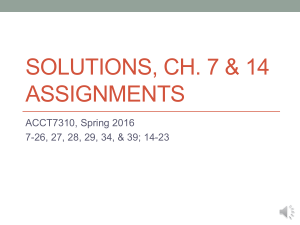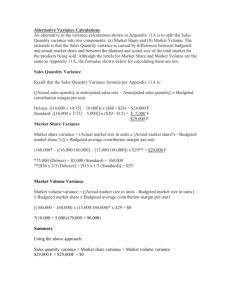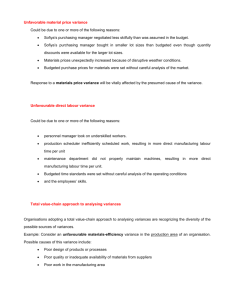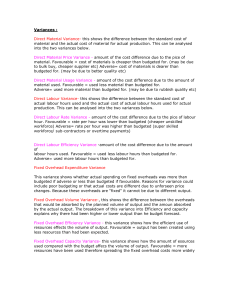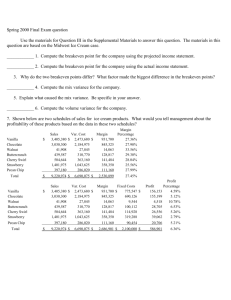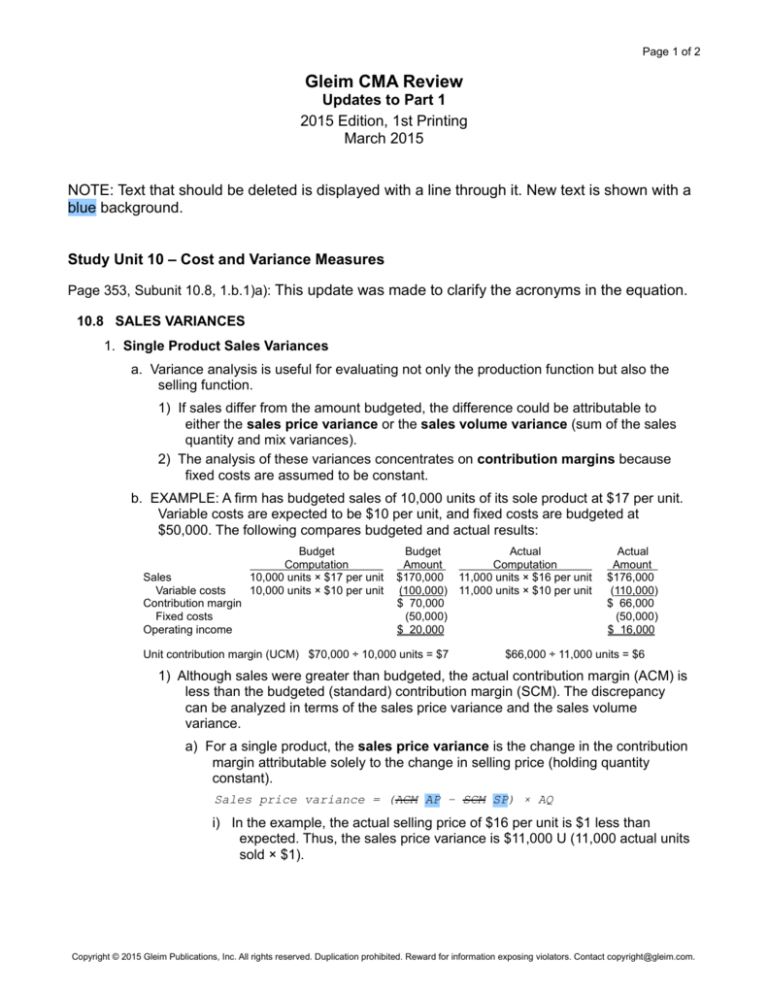
Page 1 of 2
Gleim CMA Review
Updates to Part 1
2015 Edition, 1st Printing
March 2015
NOTE: Text that should be deleted is displayed with a line through it. New text is shown with a
blue background.
Study Unit 10 – Cost and Variance Measures
Page 353, Subunit 10.8, 1.b.1)a): This update was made to clarify the acronyms in the equation.
10.8 SALES VARIANCES
1. Single Product Sales Variances
a. Variance analysis is useful for evaluating not only the production function but also the
selling function.
1) If sales differ from the amount budgeted, the difference could be attributable to
either the sales price variance or the sales volume variance (sum of the sales
quantity and mix variances).
2) The analysis of these variances concentrates on contribution margins because
fixed costs are assumed to be constant.
b. EXAMPLE: A firm has budgeted sales of 10,000 units of its sole product at $17 per unit.
Variable costs are expected to be $10 per unit, and fixed costs are budgeted at
$50,000. The following compares budgeted and actual results:
Sales
Variable costs
Contribution margin
Fixed costs
Operating income
Budget
Computation
10,000 units × $17 per unit
10,000 units × $10 per unit
Budget
Amount
$170,000
(100,000)
$ 70,000
(50,000)
$ 20,000
Unit contribution margin (UCM) $70,000 ÷ 10,000 units = $7
Actual
Computation
11,000 units × $16 per unit
11,000 units × $10 per unit
Actual
Amount
$176,000
(110,000)
$ 66,000
(50,000)
$ 16,000
$66,000 ÷ 11,000 units = $6
1) Although sales were greater than budgeted, the actual contribution margin (ACM) is
less than the budgeted (standard) contribution margin (SCM). The discrepancy
can be analyzed in terms of the sales price variance and the sales volume
variance.
a) For a single product, the sales price variance is the change in the contribution
margin attributable solely to the change in selling price (holding quantity
constant).
Sales price variance = (ACM AP – SCM SP) × AQ
i) In the example, the actual selling price of $16 per unit is $1 less than
expected. Thus, the sales price variance is $11,000 U (11,000 actual units
sold × $1).
Copyright © 2015 Gleim Publications, Inc. All rights reserved. Duplication prohibited. Reward for information exposing violators. Contact copyright@gleim.com.
Page 2 of 2
Study Unit 12 – Internal Controls -- Risk and Procedures for Control
Page 420, Subunit 12.2, Question 11: This update clarifies the answer explanation for
incorrect answer choice (B).
11. Which one of the following situations represents a
strength of internal control for purchasing and
accounts payable?
A.
Prenumbered receiving reports are issued
randomly.
B.
Invoices are approved for payment by the
purchasing department.
C.
Unmatched receiving reports are reviewed on
an annual basis.
D.
Vendors’ invoices are matched against
purchase orders and receiving reports before a
liability is recorded.
Answer (D) is correct.
REQUIRED: The strength in internal control relevant to
purchasing and accounts payable.
DISCUSSION: A voucher should not be prepared for
payment until the vendor’s invoice has been matched against
the corresponding purchase order and receiving report. This
procedure provides assurance that a valid transaction has
occurred and that the parties have agreed on the terms, such
as price and quantity.
Answer (A) is incorrect. Prenumbered receiving reports
should be issued sequentially. A gap in the sequence may
indicate an erroneous or fraudulent transaction. Answer (B) is
incorrect. Invoices should not be approved by purchasing. That
is the job of the accounts payable department. The approval of
an invoice for payment is a basic duty of the purchasing
department and would therefore not represent a strength of
internal control for purchasing and accounts payable.
Answer (C) is incorrect. Annual review of unmatched receiving
reports is too infrequent. More frequent attention is necessary
to remedy deficiencies in internal control.
Copyright © 2015 Gleim Publications, Inc. All rights reserved. Duplication prohibited. Reward for information exposing violators. Contact copyright@gleim.com.



